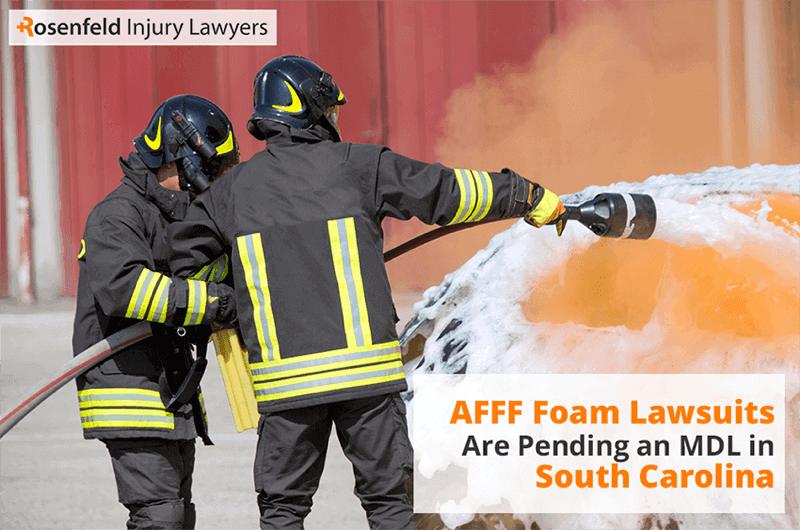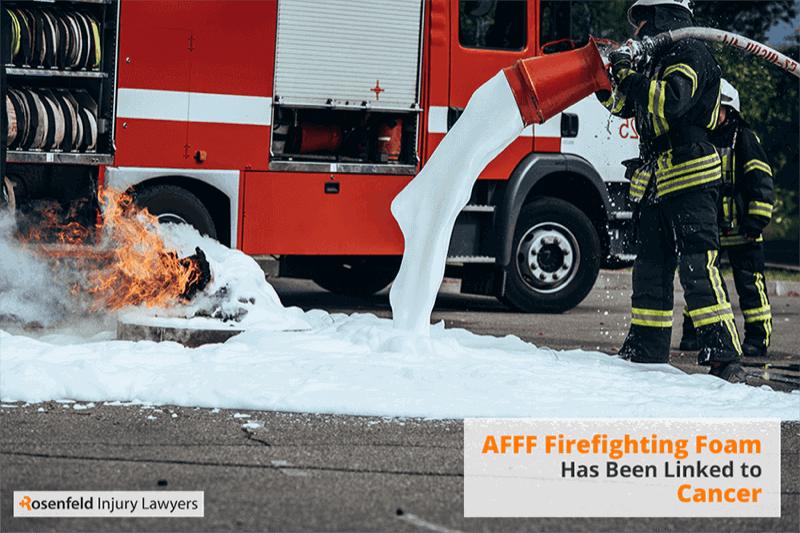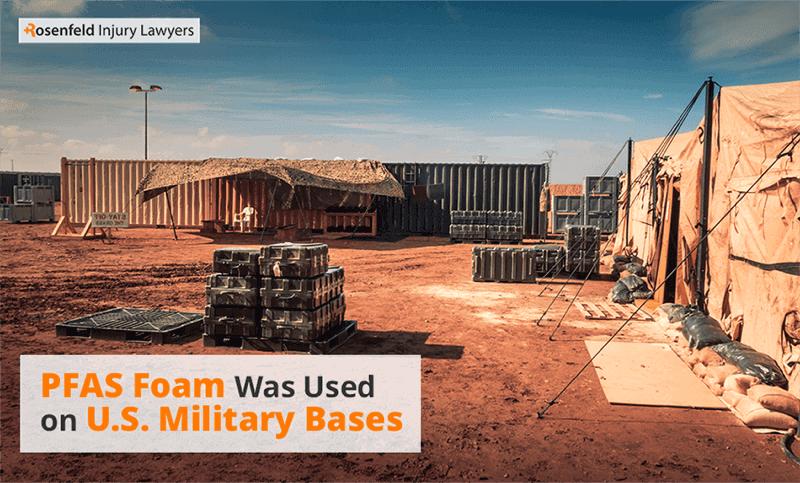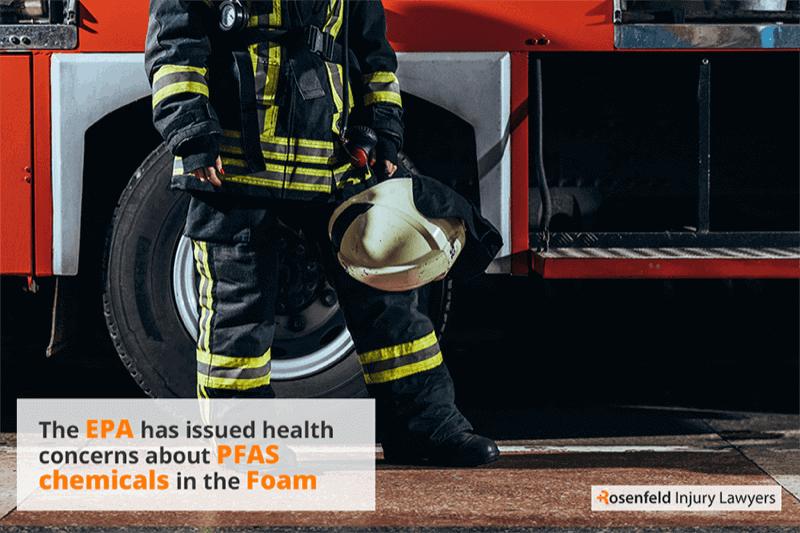- 24/7 Free Consultation: (888) 424-5757 Tap Here To Call Us
Chicago AFFF Lawsuit Lawyers

Aqueous film-forming foam (AFFF) has been associated with serious health complications, including a heightened risk of cancer, because it contains per- and polyfluoroalkyl substances (PFAS). Many AFFF lawsuits argue that the companies producing AFFF were aware of these hazards but did not adequately alert the public.
Rosenfeld Injury Lawyers is actively investigating AFFF-related claims and extending free consultations to individuals who suspect their exposure to this aqueous film-forming foam caused harm to you or your family. When you’re ready to discuss your potential claim, contact our product liability lawyers to schedule a free consultation.
What Is the AFFF Lawsuit About?
The AFFF firefighting foam lawsuit is about the injuries sustained as a result of being exposed to AFFF firefighting foam because of the chemicals in the foam, mainly PFAS.
PFAS causes people to have an increased risk of cancer, including prostate cancer, thyroid cancer, kidney cancer, and testicular cancer. At the heart of AFFF civil litigation is the duty of care manufacturers owe to consumers.
Plaintiffs in AFFF lawsuits contend this duty was breached when companies like 3M and DuPont did not provide sufficient warnings about the risks of using products containing PFAS. The AFFF firefighting foam lawsuit seeks to address this breach and compensate those harmed by AFFF.
AFFF Lawsuit Status
Because of the sheer volume of personal injury claims related to AFFF, these cases have been consolidated into a single multidistrict litigation (MDL) in the District of South Carolina. This litigation, which at one point included more than 10,000 cases, remains active, and no global settlement has been reached.
If you or someone close to you has been harmed by AFFF, there is still an opportunity to file a claim and become part of this MDL. Rosenfeld Injury Lawyers continues to accept new clients and is ready to guide you through each stage of the legal process.
AFFF Lawsuit Updates
AFFF and PFAS contamination lawsuits have been growing since 2017. Below is a general timeline and some recent updates related to the AFFF firefighting foam lawsuits.
2025
February 7
The court overseeing the AFFF multidistrict litigation will hold a hearing to consider the federal government’s request to be released from these cases. Many legal analysts believe the motion will be denied and the government will remain a defendant
The AFFF firefighting foam multidistrict litigation saw 459 new lawsuits filed in January. This surge follows a dip in October and November, when some of the settled water contamination cases were dismissed. We continue to get new cases coming our way.
January 23
A retired Yonkers firefighter has filed AFFF lawsuit, alleging thyroid disease caused by years of exposure to AFFF containing PFAS. He cites incidents like the 1996 Con Edison substation fire and claims he was misled by manufacturers about the aqueous film-forming foam’s safety.
Defendants named in the AFFF lawsuit (including 3M, Chemours, and DuPont) face accusations of negligence, hiding key information, and failing to properly warn of health hazards.
The plaintiff seeks both compensatory and punitive damages, with his spouse also requesting compensation for emotional distress.
January 21
Punitive damages are emerging as a major factor in increasing settlement values in AFFF lawsuits. Plaintiffs assert that product makers – such as 3M and DuPont – intentionally concealed the dangers of PFAS in AFFF firefighting foam for decades.
This alleged willful misconduct could result in substantial jury awards, increasing the likelihood that manufacturers will settle before trial.
January 15
Another case has been entered into the MDL by a Flagstaff, Arizona firefighter, claiming that he developed cancer of the testicles stemming from ongoing AFFF exposure during training and emergency situations.
Although his cancer was initially treated, it later returned, a recurrence he believes is linked to PFAS chemicals. His wife is also seeking damages for the emotional and financial toll of his illness.
Defendants are attempting to move the pending AFFF lawsuit to federal court.
January 7
A newly published study from The University of Buffalo provides fresh evidence on the neurological harm caused by certain PFAS compounds, linking them to cognitive and behavioral issues. This research, which focuses on how PFAS disrupt gene expression and synaptic growth, is bolstering the claims of AFFF plaintiffs who argue that PFAS/AFFF exposure has contributed to serious neurological damage.
January 3
In an effort to broaden federal oversight of “forever chemicals,” the EPA has included nine additional PFAS compounds in the Toxics Release Inventory.
January 2
As of early 2025, the AFFF MDL for the District of South Carolina includes more than 7,500 ongoing cases, with 270 newly filed in December 2024. Most of these firefighting foam lawsuit lawsuits involve personal injury from PFAS exposure via water AFFF contamination.
The rising number of claims reflects growing public awareness of serious health risks tied to AFFF firefighting foam, with many plaintiffs alleging serious illnesses, including various cancers.
2024
December 30
AFFF lawsuits involving ulcerative colitis have advanced to Tier 2 discovery within the broader AFFF and PFAS litigation. Up to four bellwether cases focusing on ulcerative colitis will now undergo in-depth fact-finding, allowing plaintiffs and defendants to refine their arguments on whether PFAS chemicals can cause or worsen this condition.
December 12
A former U.S. Navy firefighter from Ohio has filed a claim in the MDL, asserting that AFFF exposure led to his thyroid disease.
The suit alleges that major manufacturers, including 3M and DuPont, failed to warn firefighters about PFAS risks despite knowing them since at least the 1960s. This adds to a growing body of litigation linking thyroid disorders to AFFF firefighting foam.
December 10
An article recently revealed that some fire departments in Maine and throughout the nation have used AFFF foam in local parks for community activities, potentially exposing participants to harmful chemicals.
November 21
Defendants like 3M, DuPont, and Chemours appear to be under mounting pressure due to continued AFFF lawsuits. Rising legal expenses and the constant flow of new claims may prompt these companies to consider more substantial settlements in 2025 to try to avoid unpredictable jury verdicts.
November 15
A notable drop of roughly 2,800 cases in the MDL occurred in October 2024, mostly from water contamination claims that settled in 2023.
October 15
The Court proposed a way for plaintiffs to provide threshold evidence for their cases, which led to a new Case Management Order requiring a Plaintiff Profile Form (PPF). This may enhance the understanding of the scope and factual issues in the litigation
October 5
Plaintiffs face an important deadline to submit expert reports linking certain PFAS chemicals in AFFF to various forms of cancer. These reports will be critical in upcoming Daubert challenges, where defense teams will question the reliability and credibility of the scientific evidence. The outcome will shape how cases move forward.
September 9
The first Telomer Water Provider trial is set for March 3, 2025. Though separate from the main AFFF litigation, these PFAS-related suits could still impact the outcome of the AFFF MDL.
September 1
Daubert motions will be pivotal in confirming whether scientific testimony on AFFF’s link to various cancers is admissible in court. Defense teams plan to argue that the experts’ findings lack solid evidence or are excessively speculative, but given the research already introduced in Tier 1 and Tier 2 phases, many observers anticipate the court will allow the testimony.
August 5
In Zub v. 3M Company, the widow of a firefighter who died at age 35 from kidney cancer claims her husband’s extensive AFFF exposure triggered the disease. The complaint alleges that 3M and other manufacturers were aware of PFAS’s dangers but withheld that knowledge.
Compensation is sought for wrongful death and the emotional turmoil experienced by the surviving spouse.
July 22
Judge Gergel approved nine bellwether suits from the list proposed by plaintiffs, focusing on kidney and testicular cancer cases from Pennsylvania as well as thyroid cancer and ulcerative colitis cases from Colorado. This represents a meaningful win for plaintiffs, who largely succeeded in advancing the cases they deemed most representative.
July 17
Plaintiffs’ counsel suggested a targeted approach by picking PFAS/AFFF lawsuits dealing mainly with kidney/testicular cancers and thyroid/colitis issues from specific areas, aiming to expedite discovery and reduce the court’s workload.
A new investigation supports a direct correlation between AFFF usage and an increased likelihood of testicular cancer. This scientific backing strengthens the arguments of plaintiffs seeking compensation for harm linked to PFAS exposure.
July 11
A former Navy firefighter from Memphis Naval Station has initiated litigation after being diagnosed with kidney cancer. He alleges that continuous contact with Class B foam and PFAS-tainted firefighting gear is linked to his illness, seeking damages for medical costs and other hardships.
June 24
Research has shown how human skin can absorb certain PFAS compounds more easily. Short-chain PFAS readily permeate the skin, while long-chain variants can build up within tissues. This discovery bolsters firefighters’ claims that skin contact with AFFF raises their cumulative toxic load, underscoring the need for manufacturers to disclose all hazards.
May 16
Lawyers in the AFFF litigation are narrowing their emphasis to six core health concerns with the strongest evidence connecting them to firefighting foam exposure: kidney cancer, testicular cancer, thyroid disease or hypothyroidism, ulcerative colitis, liver cancer, and thyroid cancer. This strategy helps concentrate resources on cases with the clearest causal links.
May 7
CMO 26D provides a timeline for selecting Tier 2 personal injury and wrongful death bellwether cases, including those involving kidney, testicular, and thyroid cancers, as well as ulcerative colitis. It sets out deadlines for discovery, expert witnesses, and legal filings to keep progress on track.
April 12
Tyco Fire Products (a Johnson Controls subsidiary) reached a $750 million settlement with water suppliers nationwide over allegations that its AFFF firefighting foam contaminated drinking water with PFAS chemicals.
This settlement does not affect the personal injury cases that are part of the AFFF multidistrict litigation (MDL) in the U.S. District Court for the District of South Carolina.
April 10
Both sides requested additional time to finalize the proposed CMO governing Tier 2 bellwether trials. They argue that the extension will result in a more thorough agreement without postponing other critical elements of the litigation process.
April 4
A joint proposal was submitted to identify and manage conditions not yet covered in the current AFFF litigation framework. It also provides for a “Science Day,” allowing experts to present evidence on newer disease connections, guiding the court on whether to include additional illnesses in future proceedings.
March 29
In June 2023, 3M agreed to a $10.3 billion settlement, payable over 13 years, to resolve water utility companies’ claims of PFAS pollution in drinking water.
March 13
CMO 28 details the schedule for both sides to exchange studies on diseases not addressed by existing orders. This process concludes in a Science Day session, where experts will educate the judge on the latest scientific findings, shaping future Daubert decisions and trial strategies.
March 6
With PFAS also present in many types of firefighter turnout gear, the court issued CMO 5F, requiring plaintiffs who claim harm from such gear to file specialized Plaintiff Fact Sheets (PFS). This step ensures each case’s facts are recorded and ready for trial.
February 26
A firefighter from Nevada battling bladder cancer was added to the MDL, citing routine exposure to AFFF between 1992 and 1997. This further broadens the pool of claimants as more individuals recognize potential connections between firefighting foam use and serious illnesses.
February 25
Emerging studies indicate that individuals who consume more processed foods and takeout may display higher levels of PFAS in their blood. This raises new considerations for AFFF lawsuits, suggesting that combined exposures from aqueous film-forming foam and other sources could complicate health outcomes.
February 16
All parties have agreed to tolling – pause – the statute of limitation period in nine AFFF claims, ensuring these AFFF lawsuits are preserved while the parties discuss potential resolutions.
February 8
In February 2024, a federal court granted approval for a $1.185 billion agreement negotiated by DuPont, Chemours, and Corteva with public water systems (PWS), settling some legal claims over PFAS-contaminated drinking water linked to AFFF.
February 8
Legal teams are increasingly zeroing in on PFAS-related conditions such as kidney and testicular cancer, thyroid diseases, and ulcerative colitis. Individuals with extended firefighting foam contact or severe cancers are likely to receive higher potential settlements.
2023
December 31
The MDL judge allowed a delay of the trial in the case of the City of Stuart against 3M in one of the water contamination lawsuits. The City of Stuart case was set to become a test case. However, it appears the City of Stuart could settle with 3M privately, out of court.
December 6
Judge Gergel is reviewing illnesses beyond the four primary conditions connected to AFFF firefighting foam exposure. A Science Day is anticipated to evaluate updated research on additional diseases, guiding the court’s next steps.
November 30
There were 6,400 pending cases in the AFFF class action lawsuit (MDL), with about half of the pending cases being water contamination claims brought by local municipalities.
November 28
“Suggestion of Death” notices continue to surface in the AFFF litigation, underscoring the grim reality that some plaintiffs die before their claims are resolved, amplifying calls for a prompt and fair settlement process.
October 24
Recent research reveals that heightened PFOS (a type of PFAS commonly found in AFFF) levels can elevate a person’s thyroid cancer risk – further evidence reinforcing how PFAS chemicals in AFFF firefighting foam may cause various life-threatening conditions.
January 2023
The number of individual cases in the AFFF MDL increased after a new study demonstrated links between AFFF and cancer-related deaths. The first bellwether trial was scheduled to begin in May 2023. However, all municipality-related AFFF lawsuits settled before trial.
2022
September 30
The MDL judge rejected 3M’s government contractor defense in the AFFF firefighting foam lawsuits. 3M sought summary judgment claiming immunity from liability because it manufactured AFFF under a government contract. However, the court found the defense was not applicable as 3M had not disclosed information about the health risks associated with AFFF occupational foam exposure.
2021
March 31
Several product liability AFFF lawsuits were filed claiming AFFF exposure led to various cancers. These included a man diagnosed with testicular cancer, a firefighter alleging cancer from AFFF firefighting foam exposure, and a man from Arizona claiming prostate cancer due to AFFF use during his service at the fire department.
2020
May 1
During the routine status conference, both plaintiffs and defendants (including representatives of the United States) provided updates on how discovery was progressing.
April 3
At this session, all parties reported on various discovery matters, such as the exchange of documents, depositions, and the United States reviewing historical files.
Beforehand, the Court released CMO 10 and CMO 10.A, which confirmed or expanded positions on the Plaintiffs’ Executive Committee and the Defendants’ Coordination Committee for the term from March 2020 until March 2021. The Court had also previously issued CMO 9, covering the procedure for handing over subpoenaed documents from third-party sources.
March 18
Once again, both plaintiffs and defendants, along with the United States, updated the Court on the status of discovery, including the government’s ongoing historical document review.
Afterward, certain defendants met privately with the Court regarding the Defendants’ Executive Committee structure. The Court issued CMO 5.B, specifying how defendants will share costs for managing and storing Plaintiffs’ Fact Sheets.
January 10
Parties briefed the Court on discovery topics, including strategies to address missing or incomplete Fact Sheets. The Court also heard from a member of the Plaintiff Executive Committee concerning discovery requests targeted at 3M Company.
2019
December 13
At the status conference, each side, and the United States, outlined the latest progress in discovery.
November 30
The Court introduced CMO 7, which named new members to the Defendants’ Coordination Committee, and CMO 8, covering protocols for handling privileged or confidential information in discovery. Plaintiffs, defendants, and the United States all provided briefs on their ongoing discovery efforts.
October 4
In a joint event combining the usual status conference and a dedicated “science day,” the Court heard from experts on preset topics. Prior to this meeting, the Court ruled on several motions from plaintiffs seeking to amend their complaints.
Additional Case Management Orders were issued, among them CMO 2.A (covering motion procedures), CMO 3.C (covering statute of limitations tolling and adding new parties), and CMO 6 (addressing alternative service of process). The Court also announced the schedule for upcoming monthly status conferences through September 2020.
August 7
CMO 5 was released, detailing the design and usage of both Plaintiffs’ and Defendants’ Fact Sheets. One day earlier, CMO3.B granted an extension until September 4, 2019, for parties wishing to add new defendants.
July 26
At the fifth status conference, the Court examined proposals for both Plaintiffs’ and Defendants’ Fact Sheets, including how to implement the related Case Management Order. The parties were given 10 days to raise any outstanding objections.
Plaintiffs had seven days to give defendants an updated list of sites currently part of the litigation, while retaining the option to add sites in the future. The Court set the next status conference for September 6, 2019, at 9:00 A.M.
July 24
An Order Setting Science Day was issued for September 6, 2019, to follow the status conference scheduled earlier that same morning. This order clarified the planned structure and subject matter of the upcoming science presentations.
June 21
The Court discussed discovery management strategies, including the Fact Sheets for Plaintiffs and Defendants. Potential topics for a future science-focused session were also on the addressed.
June 7
Via CMO 3.A, the Court extended to August 4, 2019, the deadline by which parties may file motions to add new defendants.
May 20
CMO 4 lifted an existing pause on discovery, established a protocol for document collection, and introduced a Protective Order.
May 17
During the third status conference, the Court addressed ways to handle discovery efficiently and discussed plans for a forthcoming science day. The Court also hear from parties regarding the State of New York’s motion to remand.
April 26
CMO 3 expanded both plaintiffs’ and defendants’ committees, established payment guidelines for legal time and expenses, allowed direct filings into the MDL.
April 5
During the second status conference, the Court addressed initial concerns from the parties’ joint status report and examined the proposed scheduling order and recommendations for additional committee members.
March 20
CMO 2 was issued, assigning leadership teams for both plaintiffs and defendants and seeking nominations for additional roles. This order also set protocol standards for filing motions and scheduled the next conference.
February 25
The Court held its first status conference, where plaintiffs’ and defendants’ counsel proposed a leadership team for the MDL, and provided updates on related federal lawsuits that had not yet been moved into this district.
January 2
CMO 1 consolidated cases for pretrial purposes, created guidelines for electronic filings, and scheduled the initial status conference for February 25, 2019, at 10:00 A.M.
December 2018
The MDL was created and assigned to Judge Richard Gergel in the United States District Court for the District of South Carolina after a wave of AFFF lawsuits filed from 2017. This MDL includes claims from local governments about water supply contamination by PFAS and product liability cases alleging cancer due to AFFF firefighting foam exposure.
AFFF Lawsuit Settlement Estimations
Although thousands of AFFF lawsuits have been filed, there has been no comprehensive or global settlement reached thus far. Both plaintiffs and defense teams continue to evaluate the scientific evidence, health impacts, and legal arguments, which can affect settlement negotiations.
However, many legal experts have developed rough projections based on the severity of injuries and strength of each plaintiff’s claim.
Potential Settlement Tiers
For individuals filing an AFFF lawsuit, the following is an estimate of the potential payouts based on the severity of injuries.
Tier 1: Individuals with the most serious illnesses and extensive evidence of long-term AFFF exposure could see compensation ranging from around $200,000 to $500,000 or more. This category typically covers plaintiffs diagnosed with conditions like advanced cancers that significantly affect daily life.
Tier 2: Moderate cases may settle between roughly $150,000 and $300,000, depending on how much exposure the plaintiff experienced and the level of documented medical impact. People in this group often have illnesses requiring ongoing treatment but may not face the sustained hardships seen in Tier 1 cases.
Tier 3: Plaintiffs with less severe health outcomes or weaker proof of exposure might be awarded settlements in the $20,000 to $75,000 range. Though these amounts are lower, they can help cover medical bills, testing, and other relevant expenses.
Because every AFFF lawsuit has unique circumstances, it’s critical to consult with a qualified attorney to determine how much you may be entitled to recover.

Is There an AFFF Class Action Lawsuit?
The AFFF firefighting foam MDL in South Carolina consolidated several federal AFFF lawsuits into an MDL so that discovery and early trial processes could be handled more efficiently. Many media outlets and other lawyers may refer to this MDL as an AFFF class action lawsuit. However, technically it is not a class action lawsuit but an AFFF MDL.
How Many AFFF Lawsuits Have Been Filed So Far?
At one point, there were more than 10,000 aqueous film-forming foam cases, reflecting the widespread allegations of health risks associated with the product’s PFAS content. Some water supply cases have settled and other cases have been dismissed, bringing the count down a bit. As of February 4th, 2025, there are 7,370 active cases.
These AFFF lawsuits bring together military personnel, firefighters, and civilians who claim exposure to the foam caused various types of cancer (for example bladder cancer, breast cancer), or other serious ailments.
Many cases have been consolidated into a multidistrict litigation (MDL) aimed at streamlining pretrial proceedings and leading to settlement discussions.
AFFF (Firefighting Foam) Lawsuit Plaintiff Profile
AFFF lawsuits involve a broad range of people who believe they’ve been harmed by PFAS chemicals in AFFF firefighting foam. Although military service members and firefighters are commonly associated with these claims, civilians and other groups have also filed suits, indicating that exposure risks extend beyond professional firefighting roles.
Occupational and Industry Workers
Workers from chemical plants, airports, and other facilities where AFFF is regularly used or stored may come into contact with PFAS. Repeated handling of equipment and materials tainted by these chemicals can heighten the likelihood of health problems over time.
In these cases, plaintiffs commonly point to poor safety measures or a failure to provide adequate protective gear and training.
Local Residents in Contaminated Areas
People who live in neighborhoods near fire training sites, industrial complexes, or military bases can be exposed to AFFF through contaminated soil or water sources. PFAS levels in their groundwater may exceed recommended limits, raising concerns about possible health impacts.
Some AFFF lawsuits allege that residents had no warning about the contamination and were unable to take steps to protect themselves.
Property and Business Owners
Those who own property or operate businesses in regions affected by AFFF-related pollution may find their soil, crops, or water supplies compromised. Contamination can diminish property values, disrupt business operations, and create significant cleanup expenses.
Owners seek compensation for these financial setbacks, arguing that AFFF manufacturers and other responsible parties should pay for remediation.
Families Impacted by Secondary Exposure
Even if someone has not directly worked with AFFF, they could still face secondary exposure from a family member who brings these chemicals home on clothing or gear. Children and spouses may inhale or touch PFAS residues, increasing the potential for health issues.
Legal claims in these situations focus on the foam’s lingering presence and the manufacturers’ failure to warn about the risks of accidental transfer.
Water Utilities and Municipalities
Cities and towns tasked with providing safe drinking water often discover PFAS contamination in local water sources. These utilities and municipalities have filed AFFF lawsuits to cover the steep costs of monitoring, filtration, and other methods needed to keep water supplies clean.
By pursuing legal action, they hope to shift the financial burden of cleanup onto the parties they allege are responsible for polluting public resources.
Defendants in AFFF (Firefighting Foam) Cancer Lawsuits
There are a number of companies that manufacture or distribute AFFF that have been listed as defendants in these cases:
- 3M – 3M is one of the largest manufacturers of AFFF and is listed as a defendant in many different AFFF cases, as it has been a partner with the U.S. military for decades.
- Arkema Inc. – Arkema Inc. is one of the companies listed in AFFF-related litigation, including in Delaware.
- BASF Corp. – BASF Corp. is one of the companies listed in AFFF-related litigation, including in Delaware.
- Carrier Global Corporation – Carrier acquired AFFF manufacturers National Foam and Angus Fire.
- ChemDesign Inc – ChemDesign Inc. is one of the companies listed in AFFF-related litigation, including in Delaware.
- Chemguard Inc – Chemguard develops and produces AFFF used for fire suppression.
- Chemours – Chemours used to be a subsidiary of DuPont and is one of the primary producers of PFAS-based products like AFFF.
- Chubb National Foam Incorporated – United Technologies purchased Chubb and merged with Kidde Fire Protection to create UTC Fire & Security.
- Clariant Corporation – Clariant designed, manufactured, distributed, and/or sold fluorosurfactants used in AFFF products.
- Corteva Inc. – Corteva has faced legal action from a variety of complaints, including lawsuits from the state of North Carolina.
- DuPont – DuPont and its subsidiaries held a major market share of the AFFF market. Even though it separated from its main AFFF-producing subsidiary Chemours, it is still being held accountable for its role.
- Dynax Corp. – Dynax is a global supplier of various fluorochemical foam stabilizers, including AFFF.
- Kidde-Fenwal – Kidde-Fenwal is a subsidiary of Carrier Global Corp that filed for Chapter 11 bankruptcy protection in the “likely” event that the AFFF lawsuits exceed its capacity to pay settlements.
- Tyco Fire Products – Tyco Fire Products is an AFFF manufacturer that has already had experience paying out an AFFF class action lawsuit in the Town of Peshtigo, Wisconsin, which was settled for $17.5 million.
- UTC Fire & Security Americas – UTC Fire & Security Americas has been listed in other AFFF cases, including a firefighting foam lawsuit from the State of Michigan.
What Is AFFF?
AFFF stands for aqueous film-forming foam used to fight flammable liquid fires by creating a specialized protective film that separates fuel and air. This successfully suppresses fires by depriving the fire of oxygen. It is used extensively in firefighting operations and in the military.
However, AFFF contains PFAS chemicals. PFAS are also known as forever chemicals because they take a very long time to break down. Exposure to PFAS has been linked to both serious health and environmental problems, including different types of cancer and municipal water contamination cases.
What Are PFAS?
Per- and polyfluoroalkyl substances (PFAS) are a class of synthetic chemicals widely used because of their oil-, water-, and heat-resistant properties. They were originally developed for industrial applications like non-stick cookware, waterproof clothing, and firefighting foams, including AFFF (aqueous film-forming foam).
However, PFAS compounds do not break down easily in the environment, earning the nickname “forever chemicals.” As a result, they often persist in soil, water, and in the human body, leading to concerns about long-term health risks.
Relevance to AFFF Lawsuits
In AFFF litigation, plaintiffs often allege that PFAS in firefighting foam contributed to serious illnesses, including various forms of cancer, thyroid disease, and other chronic health conditions. The central assertion is that companies and manufacturers knew about these toxic properties but failed to inform users about potential hazards.
Individuals at highest risk typically include firefighters, military personnel, and people living near sites where AFFF has been extensively used, such as airports and military bases.
Scientific research continues to confirm the link between PFAS exposure and a variety of health problems, supporting the need for firefighting foam AFFF lawsuits that hold manufacturers accountable for damages and cleanup costs.
Why Are People Filing Firefighting Foam (AFFF) Lawsuits?
People are filing AFFF firefighting foam lawsuits because numerous areas across the United States have faced extensive PFAS contamination, particularly on military properties – leading many service members and veterans to file AFFF lawsuits.
A 2018 analysis by the Environmental Working Group (EWG) discovered hundreds of sites where drinking water or groundwater showed PFAS levels far above the Environmental Protection Agency’s recommended health limit.
This finding underlined the possibility that both military service members and those living nearby could be exposed to AFFF and PFAS chemicals. This of course caused widespread concern about long-term health consequences.
The Department of Defense (DoD) has begun investigating the extent of PFAS pollution at these installations. In a March 2022 PFAS Program Fact Sheet, the DoD outlined plans to locate contaminated zones and take steps to address ongoing health and environmental risks.
City Water Departments Filing Claims
City water departments and other government entities have also found themselves forced to deal with expensive cleanup processes. They have brought firefighting foam lawsuits against AFFF manufacturers, claiming that the companies and distributors knew PFAS chemicals were likely to contaminate ground and surface water but failed to provide adequate warnings.
Because of this lack of transparency, municipalities and nearby communities have shouldered considerable costs to eliminate PFAS from drinking water, ensuring residents can access safe resources.
Individuals Filing Claims
In addition to governmental litigation, individuals with direct occupational exposure – such as firefighters – are filing personal injury cases based on links between AFFF usage and cancers or other severe illnesses.
These individuals argue that repeated contact with PFAS from the foam, often without protective measures or clear health advisories, led to serious and life-altering health conditions.
Both government agencies and private parties point to evidence that the companies involved were aware of PFAS’s harmful properties, yet did very little to alert users or take proactive steps to prevent harm.
As a result, AFFF lawsuits revolve around serious allegations: that manufacturers not only produced a hazardous product but also failed to warn consumers, communities, or the military about the dangers.
These claims seek compensation for remediation efforts, medical costs, and other damages that plaintiffs have encountered, holding the foam’s creators liable for the impacts of significant PFAS contamination.
Health Risks Related to AFFF Exposure
While AFFF exposure poses multiple health concerns, one of the most critical issues involves understanding its potential connection to various forms of cancer.
The Link Between Aqueous Film-Forming Foam and Cancer
The Illinois Attorney General filed a firefighting foam lawsuit against 14 PFAS manufacturers, including AFFF manufacturers who allegedly knew about the dangers of AFFF for human and environmental health but didn’t advise their customers properly about the toxic chemicals.
Some of the most common types of cancer that have been shown to be linked to AFFF exposure include the following:

Kidney Cancer
Kidney cancer typically begins in the cells of the kidneys, which play a key role in filtering waste products from the blood. Some scientific findings suggest that PFAS chemicals in firefighting foam may heighten the risk of kidney cancer by disrupting normal kidney functions and hormone pathways.
Testicular Cancer
Testicular cancer affects the male reproductive glands and can impair hormone production. Studies have linked PFAS exposure, including chemicals found in AFFF, to a greater likelihood to develop cancer – particularly testicular cancer – partially due to PFAS’s ability to interfere with endocrine processes.
Bladder Cancer
Bladder cancer arises in the cells lining the inside of the bladder, which stores urine before it leaves the body. Research indicates that repeated or prolonged contact with PFAS chemicals could elevate bladder cancer risks, possibly by affecting the urinary tract’s protective lining.
Prostate Cancer
Prostate cancer develops in the prostate gland, responsible for producing seminal fluid in men. Although more investigation is needed, certain evidence points to a connection between PFAS exposure and an increased chance of prostate cancer, as these chemicals may influence hormone regulation and cell growth.
Pancreatic Cancer
Pancreatic cancer involves malignant changes in the pancreas, an organ essential for regulating blood sugar and aiding in digestion. Early studies suggest that PFAS compounds might contribute to abnormal cell development in the pancreas, underscoring the need for further research on cancer risk tied to AFFF exposure.
Thyroid Cancer
Thyroid cancer affects a gland in the neck that regulates metabolism and other bodily functions. Growing evidence connects PFAS exposure to alterations in thyroid hormone production, potentially raising the odds of developing cancer of the thyroid in individuals who have had regular contact with firefighting foam.
Breast Cancer
While research is ongoing, current findings indicate there may be a possible connection between PFAS exposure (including those found in AFFF) and breast cancer risk. However, the results are somewhat inconclusive at thet moment, as some studies point to higher risks while others do not identify a clear relationship.
Factors such as duration of exposure, individual genetics, and additional environmental influences can all play a role in determining actual risk levels.
Other Health Risks Posed by Exposure to Aqueous Film-Forming Foam
While cancer risks often dominate discussions about AFFF exposure, many other serious health concerns have been linked to the PFAS chemicals found in firefighting foam. Below are several non-cancer conditions commonly associated with PFAS contamination:
Asthma
Recent research suggests that PFAS chemicals could exacerbate or possibly trigger respiratory issues like asthma. These substances may heighten inflammation in the airways, making it more difficult for individuals to breathe.
Birth Defects
There is growing concern that PFAS exposure during pregnancy might contribute to heightened risks of birth defects.
Although more extensive research is needed, the chemicals’ ability to cross the placenta and alter fetal development is particularly worrisome. Some studies suggest these defects may be connected to how PFAS disrupt hormonal and metabolic processes.
Child Developmental Delays
Young children exposed to AFFF/PFAS may experience developmental delays, including slower growth and potential learning impairments. PFAS chemicals can interfere with hormone regulation crucial for proper neurological and physical development.
Increased Cholesterol Levels
Cholesterol imbalance is another potential effect of PFAS exposure, as some studies show that contact with these chemicals can drive up overall cholesterol and LDL (“bad”) cholesterol.
Ulcerative Colitis
Some studies suggest that PFAS exposure might be linked to ulcerative colitis, a long-term inflammatory bowel disease affecting the colon. The idea is that PFAS could disrupt immune and inflammatory responses in the gut, leading to or worsening inflammation.
Fertility Issues
PFAS can interfere with reproductive hormones, leading to fertility problems in both men and women. Couples exposed to AFFF chemicals may find it more difficult to conceive due to disruptions in ovulation and sperm production.
Immune System Deficiency
Exposure to PFAS can weaken the immune system, making it harder for the body to fight off infections. Studies point to decreased antibody responses to vaccines and a greater susceptibility to illnesses.
Over time, compromised immunity can have long-lasting impacts on overall health and well-being.
Liver Damage
PFAS chemicals have been observed to accumulate in the liver, potentially resulting in dysfunction or damage to this vital organ. Individuals exposed to firefighting foam may experience abnormal liver enzymes, indicating stress or injury to liver cells.
Preeclampsia and Hypertension during Pregnancy
Preeclampsia and high blood pressure are major threats to maternal and fetal health during pregnancy, and PFAS exposure may raise the likelihood of these complications. By interfering with normal blood pressure control and placental development, PFAS could compound the risk of serious outcomes for expecting mothers.
Thyroid Disease
Thyroid function is essential for regulating metabolism, and exposure to toxic firefighting foam can hinder normal hormone production. This disruption may result in conditions like hypothyroidism or hyperthyroidism, each with their own spectrum of symptoms such as weight fluctuations, fatigue, and mood changes.
Studies on the Serious Health Risks Related to AFFF Exposure
This AFFF litigation seems well-founded, as there is mounting evidence the PFAS chemicals found in AFFF foam are dangerous. Some of the notable pieces of research on the dangers of PFAS chemicals on human health include:
The Endocrine Society notes how PFAS chemicals disrupt the endocrine system and are found in the water near military bases and firefighting training facilities. It lists how PFAS causes reproductive harm, causes tumors and cancers, and harms liver and kidney function.
Research conducted in West Virginia linked these chemicals to testicular cancer, kidney cancer, ulcerative colitis, thyroid disease, and high cholesterol.
The Agency for Toxic Substances and Disease Registry published how high levels of PFAS exposure impact the immune system, cause the development of certain cancers, and damage the liver.
According to the Environmental Protection Agency, scientific studies show that PFAS contamination and exposure are linked to harmful health effects on humans.
Studies support the risk of occupational exposure to AFFF firefighting foam, as women firefighters in a study had higher levels of PFAS when compared with office workers.
There is a lot of evidence to support that PFAS causes both testicular cancer and kidney cancer.
In a study published in the Journal of Clinical Endocrinology & Metabolism, researchers found that PFAS have a substantial impact on human health, especially with regard to male infertility and testicular health.
Emerging research suggests that pregnant women exposed to firefighting foam/PFAS are at an increased risk of thyroid cancer.
As time passes, more studies continue to come out, detailing the dangers of these forever chemicals and linking them to harmful and life-threatening illnesses.
How Are People Exposed to AFFF Firefighting Foam
Our chemical exposure lawyers have found people can come into contact with AFFF in several different ways, ranging from direct use on the job to more indirect environmental pathways. Below are common scenarios through which exposure to PFAS chemicals found in AFFF may occur.

Occupational Exposure
Individuals who work directly with firefighting foam, such as professional and volunteer firefighters, are at a high risk of inhaling or absorbing PFAS compounds. Military personnel, particularly those involved in crash or rescue operations, also use AFFF extensively in training drills and emergency responses.
Over time, repeated handling of equipment and clothing contaminated with foam can lead to gradual buildup of these chemicals in the body.
Accidental ingestion, such as swallowing small amounts of foam during high-stress exercises, can further contribute to a person’s overall chemical load. Even with protective gear, meaningful exposure can still happen if safety protocols and decontamination efforts are insufficient.
Environmental Contamination
Communities near military bases, airports, and industrial sites may face elevated risks if AFFF is used or disposed of in large quantities. These chemicals can leach into groundwater and surface water, eventually making their way into public water supplies or private wells.
Residents who consume or bathe in this contaminated water may absorb PFAS through both ingestion and skin contact, increasing their risk of health complications.
Local ecosystems can also be affected, as PFAS accumulate in plants, fish, and other wildlife. Repeated, low-level exposure over months or years can add up and potentially lead to serious health concerns.
Secondary and Indirect Exposure to Aqueous Film-Forming Foam AFFF
Even people who do not have anything to do with firefighting foam can come into contact with PFAS through family members or friends who work with AFFF.
Microscopic particles of foam can adhere to clothing, footwear, or equipment, where they can linger and be transferred into vehicles or homes. Once indoors, these contaminants mix with dust or are released into the air, allowing others – especially children and pets – to breathe them in or touch them.
Food items can also become contaminated if stored or prepared in a setting where foam residues are present. While the levels might be lower than direct occupational exposure, persistent secondary contact can still contribute to unsafe PFAS accumulation.
Contact with AFFF-Contaminated Clothing and Gear
Firefighters and maintenance crews often wear protective gear that absorbs AFFF over repeated use, as the foam adheres to fabrics and seams.
This can lead to skin contact throughout the workday, and insufficient decontamination procedures may not fully remove the chemicals.
Washing gear at home could spread PFAS residues to family laundry, again putting household members at risk. Over time, heavily used garments may degrade and release more of these substances during regular handling.
The Environmental Impact of Aqueous Film-Forming Foam
AFFF (aqueous film-forming foam) poses substantial ecological threats because of its high levels of PFAS, a set of chemicals linked to long-term environmental harm. Over time, these forever chemicals have spread beyond the sites where they were first deployed, affecting everything from drinking water sources to diverse wildlife habitats.

Groundwater and Soil Contamination
The routine use of AFFF at military bases, airports, and fire stations has resulted in widespread PFAS infiltration into both groundwater and topsoil. This contamination compromises local drinking water supplies, leaving many communities at risk of unknowingly ingesting these forever chemicals.
Nearby agriculture can also be impacted, as crops grown in contaminated soil may absorb PFAS, furthering the problem. Detecting and quantifying the extent of this pollution can be difficult, necessitating specialized testing and monitoring efforts.
Bioaccumulation
PFAS chemicals can build up inside living creatures, moving up the food chain from smaller organisms to fish and then humans. As larger animals eat smaller ones, the total amount of PFAS can increase, raising the chances of harmful health effects.
This situation is especially concerning for people who depend on fishing or regularly eat wildlife from polluted areas. Keeping a close eye on these animal populations helps us learn more about how far PFAS contamination can spread.
Aquatic Ecosystem Disruption
Fish, amphibians, and other aquatic animals can be harmed when PFAS seeps into lakes, rivers, or oceans. Too much exposure to these chemicals can hurt their ability to reproduce, grow, and survive.
Plants and tiny organisms needed for a healthy ecosystem can also be affected, reducing food sources for many species. Over the years, this can lead to fewer types of animals living in these waters and an overall loss of healthy marine habitats.
Remediation Challenges
Despite ongoing research, current technology struggles to fully remove PFAS from contaminated sites, elevating cleanup costs and complicating long-term solutions. The Environmental Protection Agency is collaborating with scientific and industry partners to develop more efficient filtration and disposal methods.
Eligibility to File an AFFF Lawsuit
To be eligible to file an AFFF lawsuit, you must be able to prove you were exposed to AFFF and you have been diagnosed with a medical condition related to being exposed to firefighting foam.
Most of the plaintiffs in AFFF lawsuits have regular occupational exposure to AFFF, which puts them at a higher risk of developing cancers related to AFFF exposure. However, you do not necessarily need to be a firefighter to make a claim.
Generally, the plaintiffs in an AFFF case are:
- Firefighters
- Military firefighters
- Other military personnel
- People who live near sites that use AFFF, such as airports, military bases, and industrial sites
Firefighters, in particular, have an easier time when filing an AFFF firefighting foam lawsuit. There is a lot of government documentation showing firefighters are at a higher risk of developing cancers. In fact, the Firefighter Cancer Registry Act of 2018 was created as a way to monitor this correlation.
Several of the claims settled so far have been municipal water contamination lawsuits filed by local governments. PFAS contamination causes health risks and is very expensive to treat. Several of the municipal water contamination claims filed have already been settled.
The Legal Basis of AFFF (Firefighting Foam) Lawsuits
Legal actions involving aqueous film-forming foam (AFFF) often focus on two main areas – negligence and product liability – to determine whether companies failed in their responsibility to protect public health. By understanding these legal principles, individuals can better grasp how injured parties seek justice and financial recovery.
Manufacturer Negligence
Manufacturers of AFFF face legal claims asserting that they recognized the health hazards tied to PFAS but did not act responsibly to protect users. This type of AFFF firefighting foam litigation emphasize that companies misrepresented AFFF’s true risks or chose not to disclose them at all.
Plaintiffs argue that such omissions directly contributed to avoidable harm among firefighters and others regularly exposed to the toxic firefighting foam. By not taking appropriate measures or issuing timely warnings, manufacturers opened the door to legal liability for any resulting injuries.
To be eligible to file an AFFF exposure firefighting foam lawsuit and succeed, the following elements must be established.
Duty of Care
Duty of care refers to the legal obligation companies have to maintain reasonable safety standards in designing, producing, and labeling their products. In pending AFFF lawsuits, plaintiffs assert that manufcaturers should have examined the firefighting foam’s chemical content more rigorously and disclosed all potential risks.
This duty extends not just to end-users like professional firefighters, but also to nearby communities that may be impacted by PFAS contamination in water supplies. The argument is that, had the manufacturers upheld their duty, many long-term health problems linked to AFFF contamination could have been prevented.
Breach of Duty
A breach of duty occurs when a party fails to meet the required standard of care. In the context of AFFF lawsuits, plaintiffs contend that manufacturers and distributors knowingly continued to market film-forming foam (AFFF) with toxic ingredients without sufficient safeguards.
This allegedly includes neglecting to pay for more thorough safety testing, ignoring research indicating PFAS risks, and refraining from implementing safer formulations. These oversights, according to plaintiffs, amount to a clear violation of the obligations manufacturers owe to consumers and the broader public.
Causation
To establish causation, plaintiffs must show that exposure to AFFF more likely than not led to specific illnesses or injuries. In these AFFF personal injury lawsuits, individuals claim that frequent contact with film-forming foam (AFFF) containing PFAS significantly raised their risk of cancer, thyroid disease, and other serious conditions.
Detailed medical records, scientific studies, and expert testimony often serve as proof of this link. If the court agrees that the product directly caused the health problems at issue, plaintiffs will be successful in obtaining compensation.
Damages
Finally, the plaintiff must show that they suffered actual damages. Damages in an AFFF case may include medical expenses, lost wages, and compensation for pain and suffering, for example. Claimants often undergo costly treatments such as surgeries, chemotherapy, or ongoing medication as a result of PFAS-related diseases.
In severe cases, families of those who have passed away from illnesses connected to AFFF exposure seek wrongful death damages. The objective is to secure financial relief that can help cover costs related to healthcare, daily living adjustments, and emotional distress.
Product Liability and Defective Design
Product liability focuses on the inherent safety of a product and whether manufacturers adequately inform consumers of its dangers. In the AFFF context, plaintiffs argue that film-forming foam (AFFF) containing PFAS was defectively designed, making it inherently harmful.
Some also assert that any instructions provided were insufficient to prevent prolonged, harmful exposure. Under product liability law, a company can be held accountable even if it did not act negligently, provided the product is shown to be dangerously flawed.
Design Defects
Design defects occur when a product is deemed unreasonably dangerous due to how it was conceived, regardless of how carefully it was manufactured. AFFF lawsuits often claim that the chemical properties of PFAS make the film-forming foam (AFFF) toxic from its inception.
Even if users follow all recommended procedures, the product’s design can lead to long-term health risks. Demonstrating a design flaw typically involves scientific studies comparing safer alternatives and showing that the manufacturer could have offered a less hazardous option.
Manufacturing Defects
Manufacturing defects arise when the production process deviates from the intended blueprint, creating a product that is more hazardous than originally designed. In AFFF litigation, plaintiffs might insist that certain batches of film-forming foam (AFFF) contained higher PFAS levels than expected, intensifying potential harm.
These deviations can result from lax quality control, substandard materials, or oversight failures. If proven, manufacturers can be liable for releasing products that are even riskier than their already troubling design.
Failure to Warn / Inadequate Instructions
Aside from the film-forming foam (AFFF) chemical makeup, some firefighting foam lawsuits also argue that the labeling and safety guidelines were insufficient. Plaintiffs maintain that if clear and explicit warnings about PFAS toxicity had been provided, firefighters and other users could have taken protective measures.
Missing or vague instructions can form the core of a failure-to-warn claim, particularly if individuals unknowingly used the firefighting foam in ways that heightened their exposure. This alleges that manufacturers kept vital health and safety information from those most at risk.
Strict Liability
Strict liability allows plaintiffs to hold a company responsible for a defective product without proving the producer was negligent. In many states, if claimants show that AFFF was unreasonably unsafe and caused harm, liability can attach automatically.
This legal principle underscores how critical product safety is: if an item poses a clear threat to consumers, the manufacturer may be accountable no matter how diligently it tried to avoid wrongdoing. In AFFF cases, demonstrating a connection between PFAS exposure and specific illnesses can be enough to trigger strict liability.
Evidence Needed to File an Aqueous Firefighting Foam Lawsuit
Filing a firefighting foam lawsuit for injuries linked to AFFF requires specific, well-documented evidence that connects your exposure to PFAS chemicals and any resulting health problems. Below are some of the primary types of evidence needed in these cases:
Proof of Exposure
Demonstrating when, where, and how you came into contact with AFFF is essential. This could include employment records from the air force, incident reports from firefighting or military activities, or environmental testing results showing PFAS contamination and health risks in your community.
Any detailed documentation of the frequency and duration of your AFFF use can strengthen your claim.
Medical Records and Diagnosis
Comprehensive medical records help establish that you have a recognized illness or condition potentially caused by PFAS. Doctors’ reports, imaging scans, lab results, and treatment plans all play a role in linking your health concerns to AFFF exposure. Clear, updated records can also assist in calculating financial damages related to AFFF exposure medical expenses.
Expert Testimony
Experts in fields such as toxicology, environmental science, or occupational health can offer credible opinions on how AFFF might have contributed to your condition. Their findings often form a central part of successful firefighting foam lawsuits, explaining the biological or environmental pathways that connect PFAS chemicals to specific diseases.
Expert witnesses also help counter defense arguments that other factors caused your illness.
Documentation of Damages
Beyond proving a health issue, you must show how it has impacted your life. This includes evidence of lost wages due to medical leave, invoices for treatments not covered by insurance, and records of emotional distress or lifestyle changes prompted by your illness.
In wrongful death cases, families may also gather funeral expenses and documentation of lost financial support.
Consistent Personal Statements
Personal logs or diaries tracking symptom onset, medical appointments, and changes in daily routines can provide additional insight into how the exposure has affected your life. These statements can be used alongside more formal evidence to present the full scope of your experience for the court.
Making regular, dated entries can be especially persuasive in showing the progression of your health problems.
Rosenfeld Injury Lawyers can assist you in collecting and organizing these crucial materials, providing the legal support needed to present a compelling firefighting foam lawsuit and pursue the compensation you deserve.
Damages Our AFFF Lawyers Can Help You Recover
There are different types of damages you can request and add to your settlement. These include economic and non-economic damages, as well as damages related to AFFF exposure wrongful death. The types of damages available in your case will depend on the specific nature of your illness and who is filing the claim.
Economic Damages
Economic damages typically relate to what you have already spent and what you will need to spend for your ongoing care. These include:
- Medical expenses
- Rehabilitation costs
- Lost wages
- Physical therapy
- Occupational therapy
- Skilled nursing services
Non-Economic Damages
Non-economic damages do not relate to a direct monetary loss. Instead, non-economic damages are usually determined based on calculations by the court. Common non-economic damages include:
- Pain and suffering
- Lost of income potential
- Emotional distress
- Disfigurement
- Disability
Wrongful Death
In the event you are filing a wrongful death case on behalf of a spouse or parent who died from AFFF exposure, you could request compensation for:
- Medical bills
- Funeral expenses
- Lost income
- Pain and suffering
- Loss of society
- Emotional distress
Why You Need an Attorney to File an AFFF Lawsuit
Filing an AFFF lawsuit can be an overwhelming task. Claims revolve around firefighting foam containing PFAS (per- and polyfluoroalkyl substances) that have been used for jet fuel fires, military bases, and local fire departments.
Amid the ongoing AFFF litigation, which includes an AFFF MDL in the District of South Carolina overseen by a federal judge, plaintiffs have to deal with with complex scientific evidence and strict procedural rules.
Working with an attorney with specific knowledge of AFFF injury cases ensures you have an advocate who understands the serious health risks tied to these harmful chemicals. Here’s why you need a lawyer:
Legal Expertise and Experience
AFFF lawsuits involve complicated legal theories, including product liability and negligence claims, against major manufacturers such as Tyco Fire Products. Harmful substances like PFAS have implications for both the environment and human health, and an attorney well-versed in firefighting foam litigation can accurately assess each plaintiff’s case.
A lawyer’s familiarity with harmful chemicals, as well as their impacts on the human body, is critical for building a successful argument in AFFF foam exposure cases. They can also coordinate with environmental and health organizations to gather relevant research.
Navigating Multidistrict Litigation (MDL)
With so many plaintiffs exposed to AFFF firefighting foam and subsequently filing lawsuits, courts have consolidated these claims into an AFFF class action-style MDL in the District of South Carolina.
Joining an AFFF MDL can streamline pre-trial proceedings and centralize discovery against defendants, but it also means adhering to specific rules and deadlines set by the federal judge overseeing the case.
Skilled AFFF firefighting foam lawyers ensure you meet all requirements, handle coordination with potentially thousands of other claimants, and can help you decide whether joining the AFFF firefighting foam MDL or pursuing an individual lawsuit is best.
Handling Technical Evidence
Whether you’re part of the Air Force, a local fire department, or were otherwise exposed to AFFF through firefighting gear or contaminated water, proving your claim involves technical data about toxic PFAS chemicals and the significant health risks posed.
Attorneys who specialize in ongoing AFFF litigation can work with scientific and medical experts to show how per- and polyfluoroalkyl substances may cause IBD, thyroid disorders, and various forms of cancer. From analyzing complex test results to reviewing your occupational history, a lawyer’s role is essential in translating technical findings into compelling legal arguments.
Maximizing Compensation
Because of the serious health risks associated with forever chemicals, an attorney can help identify every avenue for financial recovery in AFFF personal injury cases. They’ll calculate damages that reflect not only past medical bills and lost wages but also future expenses and the emotional toll inflicted by illnesses including prostate cancer and breast cancer.
By understanding the full scope of your losses, the right lawyer makes sure you pursue maximum compensation without leaving anything on the table, whether through a settlement or a trial verdict.
If you believe you have been exposed to toxic PFAS chemicals in firefighting foam and subsequently became ill as a result, consider working with experienced firefighting foam lawyers who can guide you through this process and help protect your legal rights.
How Rosenfeld Injury Lawyers Can Help
Rosenfeld Injury Lawyers provides comprehensive representation for individuals seeking compensation and accountability in AFFF lawsuits. Whether you have faced direct PFAS (per- and polyfluoroalkyl substances) exposure through firefighting foam or suspect second-hand contamination, our firm has the experience and resources to handle these complex cases.
Here’s how we can help:
Case Assessment
Our team starts by conducting a thorough review of your circumstances, including medical records, ways to show that you were exposed, and how the situation has affected your life – in more ways than financial losses.
We will determine if you case is appropriate for the ongoing AFFF MDL currently consolidated in the District of South Carolina. By evaluating your situation in its entirety, we then develop a legal plan that addresses your specific health concerns and potential damages.
Strategic Representation in AFFF Firefighting Foam MDL Proceedings
AFFF lawsuits are consolidated into an MDL AFFF class-action type suit, where a federal judge coordinates pretrial matters for numerous similar claims. We help navigate these procedural steps, which can be incredibly confusing for a person or attorney who doesn’t have the right experience and knowledge.
With decades of experience, we can ensure your case is presented effectively against major manufacturers. Our firm’s familiarity with harmful PFAS chemicals and their significance in product liability law strengthens your position throughout negotiations or court proceedings.
Access to Scientific and Medical Experts
These toxic exposure firefighting foam lawsuits rely heavily on technical evidence to prove the link between AFFF foam exposure and significant health issues posed by forever chemicals. We maintain relationships with respected professionals – ranging from toxicologists to environmental health researchers – who can offer persuasive testimony and support your claim.
Maximizing Your Compensation
From calculating current medical costs to projecting long-term needs if you develop cancer, inflammatory bowel disease, thyroid issues, or other health conditions linked to AFFF, our attorneys strive to secure the greatest possible recovery.
We win cases at trial, which makes defendants and insurance companies take us seriously in settlement negotiations. We’ll do everything we can to get you the most amount of money.
Timely Filing and Guidance
Statutes of limitations in toxic exposure cases can be strict. Our attorneys keep you informed about all relevant deadlines and filing requirements. We also communicate regularly to ensure your case moves forward efficiently and that you understand each phase of the litigation process and feel supported at every step.
How to File an AFFF (Firefighting Foam) Cancer Lawsuit
To file an AFFF lawsuit, you generally need to follow these steps:
Schedule a free consultation with a law firm to discuss your AFFF firefighting foam lawsuit
The first step in filing an AFFF firefighting foam lawsuit is to determine whether you have a case. Simply developing cancer after potential PFAS exposure isn’t enough. Schedule your free consultation so our legal team can assess your case.
Gather evidence to support your claim
To win an AFFF lawsuit, you will need to prove you were exposed to firefighting foam. This includes gathering evidence of your exposure, collecting health records, and, in some cases, getting expert testimony. If we move forward with your claim, this is something our lawyers and investigators will do.
File a complaint
Depending on the exact nature of your case, you may have the option to join the MDL for the District of South Carolina and potentially receive compensation through a global settlement or file a separate AFFF lawsuit.
Determine the value of your case
It’s important to assess how large of a settlement you will need to pay your past and future expenses. Your AFFF lawyer can help you determine what a fair settlement would look like in your AFFF lawsuit.
What Can Affect Your AFFF Lawsuit Payout?
There are a number of factors affecting the settlement amount in AFFF cancer cases. These include:
Type and Severity of the Injury
In aqueous film-forming foam (AFFF) cancer cases, the type of illness you develop (cancer, for example) and how serious it is can greatly impact your potential settlement or verdict.
Conditions like kidney and testicular cancer often bring higher compensation because they typically involve more aggressive treatments, longer recovery times, and greater long-term health risks.
Meanwhile, diseases considered more manageable or less life-threatening, such as certain thyroid disorders, may be valued lower by insurance companies and court systems. Here’s what is usually consider when awarding damages or negotiating a settlement:
Extent of Your Losses
The overall financial and personal toll of your illness plays a big role in determining how much you might recover. This includes medical bills, costs for ongoing treatments or therapies, lost wages if you cannot work, and non-economic damages like pain and suffering.
If your condition has forced you to stop working or make significant changes to your lifestyle, these more substantial losses may lead to larger settlement amounts.
Having an Aggressive AFFF Lawyer
Choosing an AFFF lawyer who is ready to fight for the maximum possible compensation can significantly influence your AFFF firefighting foam lawsuit payout. Manufacturers and their insurers often start negotiations with low offers, hoping you will settle quickly.
An experienced AFFF lawyer who is not afraid to threaten to or actually proceed to trial can pressure these companies to raise their settlement offers. By building a strong case and demonstrating they are prepared to go to court, aggressive attorneys are more likely to secure sizable settlements for their clients.
Strength of Your Evidence
The quality and quantity of the evidence you present can significantly impact your settlement amount. Strong medical documentation, expert witness testimony, and clear proof of exposure all build a more compelling argument that PFAS contaminants in AFFF caused your injuries.
The stronger your evidence, the harder it is for the defending party to dispute the link between aqueous film-forming foam and your illness, often leading to higher settlement figures. Rosenfeld Injury Lawyers can provide personalized guidance and more information on all the factors that can influence your AFFF lawsuit payout.
Are AFFF (Firefighting Foam) Products Recalled?
AFFF foam is still being used in the United States due to its effectiveness. However, the U.S. Department of Defense has started looking for replacements and alternatives to AFFF firefighting foam utilizing PFAS and other toxic chemicals. In its report, the Department of Defense said they planned to ban PFAS AFFF on all military installations as of October 1, 2024
Currently, as of February 2025, the military is still using AFFF, but with less frequency. They have stopped using it in testing and training exercises,, but still use it when there are fire emergencies.
Additionally, the National Fire Protection Association issued its roadmap program to move away from AFFF firefighting foam containing PFAS. It held workshops to help firefighters switch from fluorinated foam to safer technology and best practices for fighting Class B fires.
A number of states have also placed limits or outright bans on firefighting foam. In areas where it’s still allowed, there may be other regulations, like requiring businesses to report any discharges. Additionally, more states are forbidding or restricting firefighter personal protective equipment (PPE) that contains PFAS compounds.
AFFF Lawsuit FAQs
Is AFFF Firefighting Foam Toxic?
AFFF (aqueous film-forming foam) can be incredibly harmful, primarily because it often contains PFAS—“forever chemicals” linked to various health issues. While AFFF is highly effective at extinguishing fuel-based fires (like jet fuel), PFAS compounds resist breaking down in the environment, potentially contaminating soil, water, and even the human body and human tissue.
People exposed to AFFF for extended periods, such as firefighters or those living near military bases and airports, could face an increased risk of health problems, including certain cancers and developmental issues.
Which AFFF Firefighting Foams Are Dangerous?
Any firefighting foams containing per- and polyfluoroalkyl substances (PFAS) present significant health concerns because these “forever chemicals” do not readily break down in the environment.
Specifically, AFFF products incorporating older PFAS compounds like PFOS and PFOA have drawn the greatest scrutiny due to their links to cancer, thyroid disease, and other medical problems.
Even newer PFAS formulations under different brand names face legal challenges and research scrutiny, as they still tend to accumulate in human tissue and persist in soil and groundwater. As a result, most foams marketed or used before the industry’s shift to “PFAS-free” alternatives are considered potentially hazardous.
Who Is at Risk for Exposure to Toxic AFFF Firefighting Foam?
Primarily, individuals working in professions that regularly utilize firefighting foam – such as firefighters, military personnel, and airport staff – face the highest risk of toxic AFFF exposure.
Additionally, those living or working near sites with frequent firefighting foam application – like military bases, airports, or industrial facilities – may encounter contaminated soil and water, leading to unanticipated exposure.
Over time, the chemicals in these firefighting foams can accumulate in the body, potentially resulting in long-term health complications.
Even those who do not directly work with firefighting foam can be affected if they live near or share a home with individuals using AFFF on the job. Microscopic PFAS particles can also cling to clothing and equipment, traveling into vehicles and households.
Additionally, anyone in communities with contaminated groundwater or private wells may be inadvertently exposed to AFFF through drinking water or agricultural produce, placing them at increased risk for potential health concerns.
What Is the AFFF (Firefighting Foam) Lawsuit Deadline?
The statute of limitations for any AFFF personal injury case is dictated by the jurisdiction where the case is filed, which varies from state to state. However, the main AFFF lawsuit is a federal case being tried as an MDL.
This can make it more difficult to determine which statute of limitations applies in an AFFF lawsuit. It often takes many years, if not decades, to develop cancer after PFAS contamination. This is much longer than most statutes of limitations allow.
Under the discovery rule, you may have some time after you have been diagnosed with cancer or another serious injury to take action. Just know that this time isn’t indefinite. The sooner you are able to take legal action, the better in terms of being able to file your claim.
How Can AFFF (Firefighting Foam) Lawyers Help Me?
An AFFF firefighting foam lawyer from Rosenfeld Injury Lawyers can help you:
- File an AFFF lawsuit in the appropriate court while meeting any applicable deadlines
- Avoid common mistakes and errors that can cause AFFF lawsuits to be dismissed
- Build a strong case proving how your exposure to aqueous film-forming foam caused the development of cancer or another serious health condition
- Negotiate the terms of potential settlements with the legal team of manufacturers and distributors
- Advocate for the highest award amounts possible for your case by using precedent to establish what is fair
- Represent you in court, if necessary, in the event your AFFF lawsuit claim is denied
Is Hiring an AFFF (Firefighting Foam) Attorney Expensive?
Working with an AFFF lawsuit lawyer is not expensive. Our firefighting foam law firm works on a contingency fee basis. This means we don’t charge you anything out of pocket or upfront for our services in filing your AFFF firefighting foam lawsuit.
Instead, we receive a set percentage of the settlement we help you secure. This way, you don’t have to pay anything to get started with your AFFF foam cancer lawsuit. You only have to pay for our services once we help you win your case, and that comes out of the settlement and not your own pocket.
Can You File an AFFF Lawsuit on Behalf of a Family Member Exposed to AFFF?
Yes, you may be able to file an AFFF lawsuit on behalf of a family member who passed away or became incapacitated due to PFAS exposure. Wrongful death lawsuits allow surviving relatives to seek compensation for losses such as medical bills, funeral expenses, and loss of consortium.
You need to show that your loved one’s health problems were tied to them being exposed to firefighting foam and that the manufacturer or another party was negligent or the product was inherently dangerous. Our experienced attorneys can guide you through the process, ensuring your case is submitted properly and on time.
Has Anyone Received an AFFF Settlement?
With any AFFF cancer lawsuit, it makes sense to see what past cases have settled for. Most of the AFFF firefighting foam cases have not reached a settlement. However, here is a growing list of settlements reached for PFAS-related injuries:
- DuPont was ordered to pay an Ohio family $50 million after a testicular cancer diagnosis related to PFAS.
- The Village of Farmingdale received a settlement worth up to $5 million from DuPont, Chemours, Corteva, and 3M in its PFAS contamination lawsuit.
What Is the AFFF MDL?
The AFFF Multidistrict Litigation (MDL) is a legal procedure in which numerous lawsuits around the country involving firefighting foam are grouped under one court for pretrial proceedings.
By centralizing these cases in the District of South Carolina, the judicial system makes it more efficient to handle common issues, such as whether PFAS and other toxic chemicals in AFFF foam contributed to cancers and other health problems.
While preserving each plaintiff’s individual claim, the MDL streamlines evidence-gathering and can lead to broader settlement negotiations.
What Is the Average AFFF Settlement Payout?
Most of the AFFF lawsuits are still pending, so it is unclear how much most AFFF settlements will be worth. Your AFFF attorney can give you a better idea of what to expect based on your condition, losses, and the amount of evidence you have to link to your exposure to AFFF.
Contact Our Experienced AFFF Lawyers Today!

If you have been exposed to firefighting foam and subsequently developed cancer or another serious health condition related to exposure to PFAS, including occupational exposure, you could potentially file an AFFF lawsuit to recover compensation for your AFFF personal injury claims. We have helped other clients recover millions. There is no cost for our services until we win your AFFF firefighting foam case, as we work on a contingency fee basis.
Contact the AFFF lawyers at Rosenfeld Injury Lawyers for a free case review by filling out our contact form or calling toll-free at 888) 424-5757. A member of our team is available 24/7 to answer your call and schedule your free consultation.
Specific Cases We Handle
- Airbag Failure Lawyer
- CooperSurgical IVF Contamination Lawsuit Lawyers
- Dangerous Drugs
- Defective Car Seat Lawyer
- Defective Ladder Lawsuit
Resources: [1] U.S. Congress, [2] Bloomberg Law, [3] Business Wire, [4] Office of the Illinois Attorney General, [5] Endocrine Society, [6] Science Panel, [7] ATSDR, [8] EPA, [9] Environmental Science and Technology, [10] Environmental Research, [11] JCEM, [12] National Cancer Institute, [13] Delaware Business Times, [14] Carrier, [15] Chemguard, [16] Firefighting Wiki, [17] State of Connecticut, [18] North Carolina DOJ, [19] Reuters, [20] Tyco, [21] State of Michigan, [22] U.S. DOD, [23] National Fire Protection Association,
All content undergoes thorough legal review by experienced attorneys, including Jonathan Rosenfeld. With 25 years of experience in personal injury law and over 100 years of combined legal expertise within our team, we ensure that every article is legally accurate, compliant, and reflects current legal standards.







